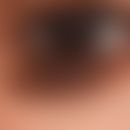Synonym(s)
HistoryThis section has been translated automatically.
Rayer, 1835; Addison and Gull, 1850
DefinitionThis section has been translated automatically.
Plane, in the area of the upper and lower eyelids localized xanthomas. The term "xanthelasma" was also used in older literature for plane xanthomas not localized at the eyelids (see index).
You might also be interested in
EtiopathogenesisThis section has been translated automatically.
Mostly idiopathic. In larger studies, associations with dyslipidemias(hyperlipoproteinemia type III and hyperlipoproteinemia type II), hypertension (40%), diabetes mellitus (18%) were found in 60% of cases.
Rarely familial clustering.
ManifestationThis section has been translated automatically.
Age at first appearance of planar xanthomas of the eyelids: 40-60 years. m>w.
ClinicThis section has been translated automatically.
0.1-2.0 cm, white-yellow, flat, rarely nodular, soft, oval, but also stripe-shaped spots or plaques, papules or nodules with a smooth surface.
HistologyThis section has been translated automatically.
TherapyThis section has been translated automatically.
Operative therapieThis section has been translated automatically.
- Removal by electrocautery, if necessary under local anaesthetic. Practical procedure: Fix and tighten the eyelid by an assistant. Using the stably guided masticatory needle, pierce the xanthelasm to a depth of about 1 mm and apply a short current pulse of medium intensity. The current causes focal destruction of the fat-storing macrophages, leakage of free fat into the tissue and induction of granulation tissue with degradation of the damaged or destroyed fat-storing cells. Set current marks at intervals of 2-3 mm! Cave! By leaving bridges of intact skin spaces, extensive necroses are avoided. Good cosmetic end result.
- After the procedure, largely dry wound treatment, if necessary disinfecting external agents, e.g. polyvidon iodine ointment (e.g. Betaisodona). The cautery-induced inflammatory reaction subsides after 3-4 weeks, cautery scars are almost not visible after healing. If residuals are still present, cauterization should be repeated. Principle: It is better to carefully chew several times than to place a large necrosis once!
- Instead of cauterization, lasers (e.g. Erbium-YAG-Laser) can be used. In this case, an analogous principle to that used in cautery surgery is followed by setting energy-defined laser marks at intervals of 2-3 mm (energy: 600-700 mJ/cm2, focus-skin distance = 1.5-2.0 cm, diameter of the laser beam: 1.0-1.5 mm).
- When ablating with curettage, the aim is to curet the xanthelasma flat. The procedure requires long personal experience and great tactile skills (only possible with a helper who fixes the eyelid tightly).
- Smaller xanthelasma can also be excised in a narrow-spindle manner. The scar conditions in the eyelid area are generally very satisfactory with a good surgical technique.
Progression/forecastThis section has been translated automatically.
Note(s)This section has been translated automatically.
In the so-called Copenhagen Heart Study (included were 12,745 adult Danes, 33 years), the result showed that the carriers of xanthelasma have an increased cardiovascular risk even when other risk factors such as age, sex, cholesterol and triglyceride levels, body mass index, hypertension, diabetes, smoking, alcohol and lack of exercise were taken into account. According to the adjusted analysis, xanthelasma increased the risk of myocardial infarction by 48%. The risk of ischemic heart disease increases by 39% and the risk of death by 14% (Christoffersen et al. 2011).
It is reasonable to assume that xanthelasma is not just an indicator of hypercholesterolemia. It is possible that these patients have a tendency to deposit cholesterol in the tissue, not only in the skin but also in the blood vessels (here formation of atherosclerotic plaques) or in the cornea of the eye (here: arcus senilis).
LiteratureThis section has been translated automatically.
- Apfelberg DB et al (1987) Treatment of xanthelasma palpebrarum with the carbon dioxide laser. J Dermatol Surg Oncol 13: 49-51.
- Borelli C et al (2001) Xanthelasma palpebrarum: treatment with the erbium:YAG laser. Lasers Surg Med 29: 260-264
- Christoffersen M et al (2011) Xanthelasmata, arcus corneae, and ischaemic vascular disease and death in general population: prospective cohort study. BMJ 343:d5497
- Dey A et al (2013) Cardiovascular profile of xanthelasma palpebrarum. Biomed Res Int doi: 10.1155/2013/932863.
- Lee MW et al (2003) Extensive xanthelasma associated with anaplastic large cell lymphoma and hyperimmunoglobulin E syndrome. Int J Dermatol 42: 944-946.
- Ronnen M et al (1989) Treatment of xanthelasma with Solcoderm. J Am Acad Dermatol 21: 807-809.
- Rose EH et al (1987) Unilateral invasive xanthelasma palpebrarum. Ophthal Plast Reconstr Surg 3: 91-94.
Incoming links (23)
Addison, thomas; Adiposity skin changes; Arcus senilis corneae; Camouflage; Cholesterodermia; Cholesterol, extracellular; Contagious mollusc; Erbium yag laser; Hypercholesterolemia familial autosomal dominant; Icterus intermittens juvenilis Meulengracht; Gilbert-Syndrom; Morbus Meulengracht; Gilbert-Meulengracht-Syndrom; ; ... Show allOutgoing links (9)
Arcus senilis corneae; Curettage; Electrocoagulation; Erbium yag laser; Hypercholesterolemia familial autosomal dominant; Lipoprotein (a) hyperlipoproteinemia; Trichloroacetic acid solution 30%.; Wound treatment; Xanthoma;Disclaimer
Please ask your physician for a reliable diagnosis. This website is only meant as a reference.














